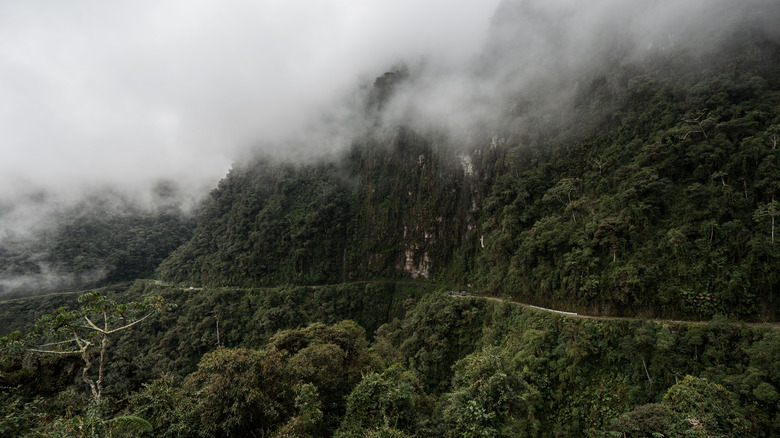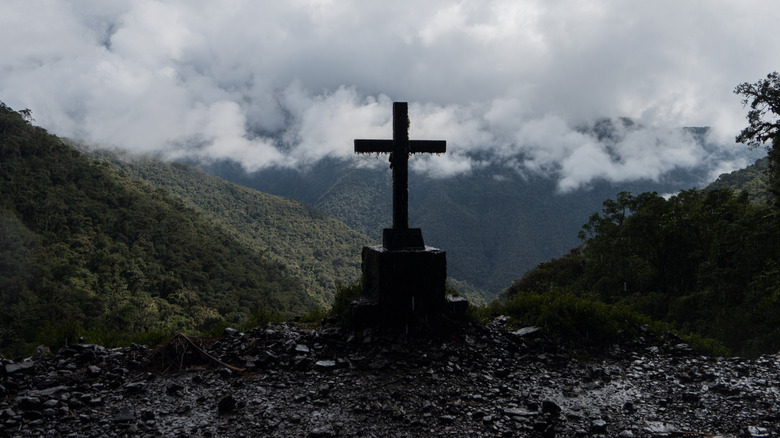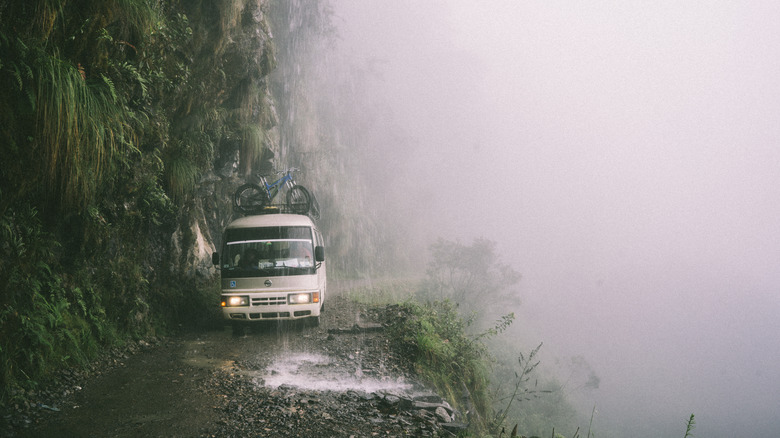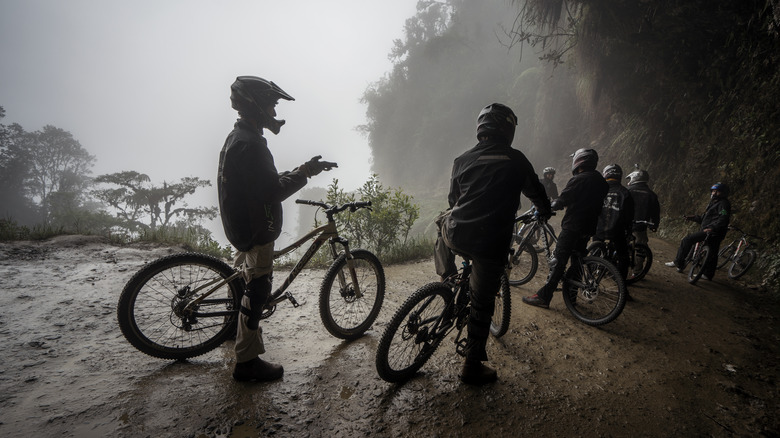This Road In Bolivia Is One Of The Most Dangerous Places On Earth
In the mountains of Bolivia, a lonely, two-lane highway clings to the sheer cliffs between the capital city of La Paz and the frontier town of Coroico. This road, only 43 miles long (or 69 kilometers) and about 12 feet wide, is formally called the Yungas Road. But since the 1930s it has earned another, more thrilling name: the Death Road (per Discovery). In 1995, the Inter American Development Bank named the Yungas Road "the most dangerous road in the world," according to the BBC, and with good reason. Until 1994, an estimated 300 people died on the road every year, many falling off the road and down the 2,000-foot cliff along its bank (via Atlas Obscura, posted on Slate).
Mountain roads are often dangerous, with their hairpin turns and long, fatal drops. But the Yungas Road has more than its share of unique driving challenges. Huge rocks spike out of the mountain face and sometimes fall into the road unexpectedly, according to The Culture Trip. Thick fogs envelop the road like wool. Cars, trucks, and bicycles all share the left-hand side of the road, which is said to make passing safer, even though Bolivians generally drive in the right lane. Until recently there were no guardrails, apart from the crosses you might have found along the edges of the road in memory of those who have died on its short route.
A history of sweaty palms
The Yungas Road was built in the 1930s by Paraguayan prisoners of war following the Chaco War. It's unclear how many of those men perished digging the highway from the steep cliffsides of the Cordilleras Mountains. Originally, the road was a one-lane path that had to accommodate all kinds of traffic — it was the only route from Coroico to La Paz until 2006, according to Discovery. That year, the Bolivian government built Route 3, a paved, two-lane alternative to the Yungas Road. But people keep using the old road despite the alternative.
It's partly the danger that draws them. Tens of thousands of cyclists brave the murderous mountain path every year, often just for the bragging rights and the spectacular views (via BBC). Some companies even offer tours of the route for adventurous cyclists, with a cost of $50 to $110 for their trouble, according to The Culture Trip. "I asked myself a thousand times 'Why am I doing this?'" said Marte Solberg, a young Norwegian tourist to Bolivia who admitted to crying with worry before the ride, to the BBC. "The answer is that firstly, everyone is doing it. If you come to Bolivia, you have to cycle down the most dangerous road in the world. And secondly, it's a personal challenge."
A less deadly Death Road?
There has always been an air of danger and glory about Bolivia, the country where romantic icons like Che Guevara and Butch Cassidy and the Sundance Kid met their gruesome fates. Perhaps risk-taking is irresistible in this place. Luckily, the danger is somewhat less mortal than it was: In the past decade, the road only claimed about a dozen cyclists. As the road continued to be open to drivers and cyclists, the government began building safety measures to ward the "Death Road" designation away.
According to Discovery, the Yungas Road now has two lanes, a paved surface, drains, and even guardrails, at least along some sections (via Slate). Bike tour operators say some of the risks can be mitigated by common sense measures. "It is our belief that the vast majority of the risk can be mitigated by providing people with great bikes and equipment, lots of instruction, and lots of warnings about the potential for accidents," said Alistair Matthew, a New Zealander who began a tour company in Bolivia, to the BBC. "However, this also means constantly monitoring groups to provide extra warnings to over-excited people and more coaching to less experienced riders."
Biking Yungas Road is still a risky trek
Matthew told the BBC that his tour company, called Gravity, has had just one casualty, a man in his 50s. Still, he says, every two weeks, someone from one of his tour groups needs to go to the hospital.
Interested yet? If so, Gravity provided a list of dos and don'ts to the BBC for people interested in biking down Death Road. Riders shouldn't try to race down the mountain path, or make the journey with a hangover. Riders should definitely avoid the rainy season, when the overhead rock faces can turn into waterfalls, unless you're an experienced mountain biker. Instead, listen to the tour guides, stay in communication with the other bikers along the route, and dismount from your bike before taking photos.
It's an unpaved "bike ride like no other ... nearly all downhill," as the BBC characterized it. Word to the wise: Before you start, check your brakes.



